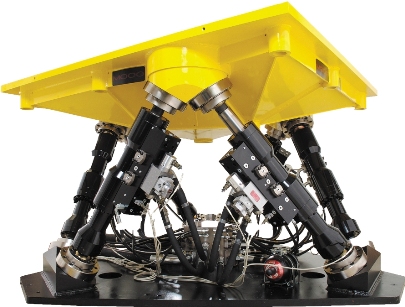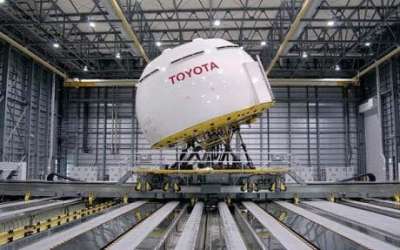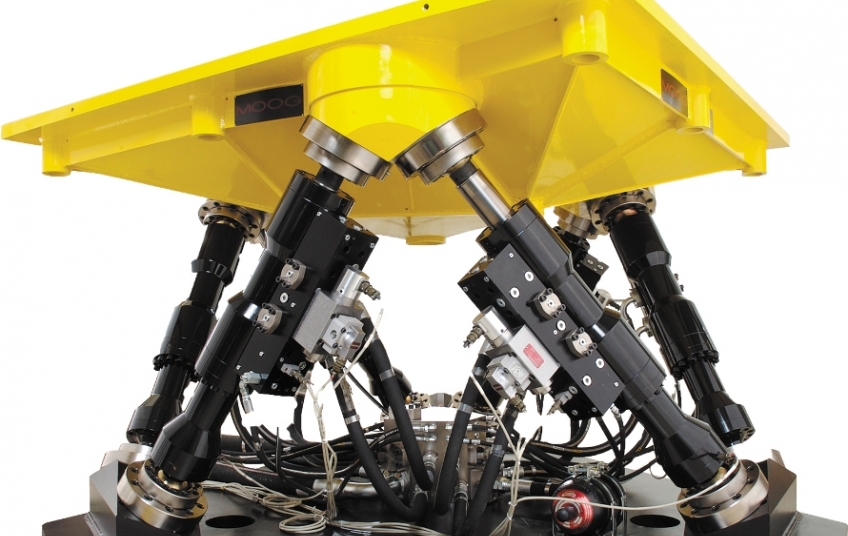Within various companies, there are always different challenges. One of the challenges throughout these companies is the design process of a package. The design process takes longer than it needs to be because of the different angles the package has to be tested. One way of solving this challenge is by using a Multi-Axial Vibration Table, also known as Multi-Axial Shaker Table (MAST).
The purpose of the Multi-Axial Shaker Table (MAST) is to simulate the vibrations of various vehicles, as well as earthquakes, on all sides of a product or condition by going in six degrees of freedom. “To achieve this motion the system is equipped with a table on which different servo hydraulic cylinders act in three orthogonal different directions. In addition, the system has a set of hydraulic and pneumatic actuators of different capacities with its respective forces and displacement sensors,” (- Multi).

Figure 1: Multi-Axial Vibration/Shaker Table
This vibration table allows the tests to be more realistic, which can make the product safer. This allows the product to have the best packaging for the product to survive and gives a full spectrum of simulation requirements. Figure 1 shows a picture of a MAST.
There are many benefits of a MAST. A MAST has speed, flexibility, and reliability. The speed allows easy operation and saves time whether it is in the market or long-term costs. For flexibility, the software for the MAST allows the controller to customize the tests the company wants to apply in order to test the product for their desired use. The Multi-Axial Shaker Table is also reliable. There is little maintenance and zero-backlash bearings, which optimizes both performance and dependability. The benefits of speed, flexibility, and reliability that all come with a MAST allow the vibration table to be used in many applications, such as the automotive industry, aerospace industry, or by civil and other engineers.
The MAST is useful because it can be used in many different applications. The vibration table is realistic because the environment can be controlled; therefore, people can use the MAST to test any environment around the world. For example, a MAST is often used for testing in the automotive industry. Around the world, there are many automotive parts that are made differently in various countries. Due to the change in temperature and humidity around the world, many parts are able to hold up well in some countries, but not in others. For an automotive, the MAST tests the fuel tanks, batteries, seats, and sunroofs. Figure 2 shows testing of automobile seats on a MAST.

Figure 2: Seat Simulation
For vehicles, the shaker tables test the durability, noise, vibration, ride comfort, and models. Durability makes sure the various components in the vehicles such as the cooling system and seats, are properly placed and intact. Next, the MAST tracks the noise and vibration. The noise and vibrations are tracked, so the consumer will like and purchase the vehicle. The door panels and other assembles are the key noises and vibrations one is looking for. Next, is the ride comfort. Along with the noise and vibration, the consumer who is purchasing the vehicle must also be comfortable while the vehicle is in operation. Finally, to save time, money, and the amount of resources, a company uses a software to model a product which predicts the performance. This allows a company to minimize the number of prototypes they have to make. While the parts of a vehicle are simulated, a person’s driving can be simulated. Sophisticated MTS [a company] Driving Simulators are used to replicate the forces and motions of a maneuvering vehicle to study vehicle safety systems, road and highway designs, and driver behavior. The simulator features a turntable version of a 6DOF hexapod MAST driven by a custom motion control system. The large dome in Figure Three can hold a full-sized vehicle.

Figure 3: Driving Simulation
A MAST has various frequencies depending on the given conditions. A frequency from 80 Hz-400 Hz is used for smaller items. For large building structures, the frequency response is from 0.1 Hz to 100 Hz in three to six degrees of freedom. See Table 1 for other specifications for a Multi-Axial Shaker Table. The vertical and horizontal forces, as well as the vertical and horizontal strokes, allow the vibration table to move and record the vibrations in different directions, simulating real-world conditions. The hydraulic power for each table is high, allowing the MAST to produce more power. There are different MASTs that perform in different ways, due to the different parameters and wide range of forces for each vibration table.
Table 1: Specifications for MAST
|
|
From |
To |
|
Table Size |
0.5m |
6m x 6m |
|
Table Mass |
50 kg |
37,000 kg |
|
Resonant frequency |
2000 Hz |
120 Hz |
|
Vertical force |
10 kN |
1000 kN |
|
Horizontal force |
5 kN |
600 kN |
|
Vertical stroke |
50 mm |
300 mm |
|
Horizontal stroke |
50 mm |
300 mm |
|
Hydraulic power |
35 kW |
1550 kW |
In conclusion, the Multi-Axial Vibration (MAST) is different from other tables because of their applications and technicalities. The applications the MAST uses simulate real-world situations, such as the vibration of vehicles, or the vibration of earthquakes, by using the six degrees of freedom. The software that is used allows one to adjust the conditions accordingly to make the real-world situations more realistic, depending on the particular product. Also, the Multi-Axial Vibration Table saves money, time, and the amount of resources that are needed to perform testing. Overall, the MAST is a beneficial vibration table to use in the long run, as well as help the consumer ensure their product is safe.
References
"Industry-Leading Testing and Sensing Solutions." MTS | Testing Systems, Mechanical Testing and Sensing Solutions. N.p., n.d. Web.
"I.Ytimg.com Ytimg Website and Webhosting Information." I.Ytimg.com - Ytimg | Website. N.p., n.d. Web.
"– Multi Axis Shaking Table." Elogistica. N.p., n.d. Web.
"Multi-Axial Vibration and Earthquake Simulation." Servotest - Test & Motion Simulation. N.p., n.d. Web.


































